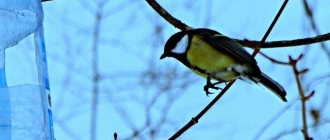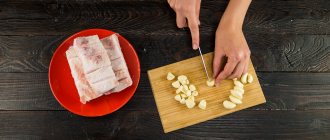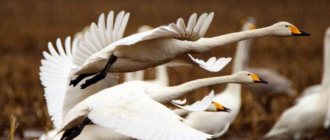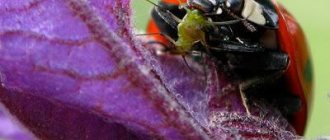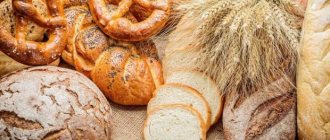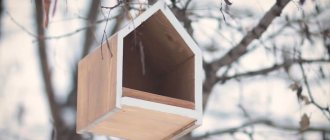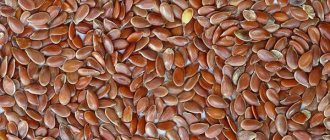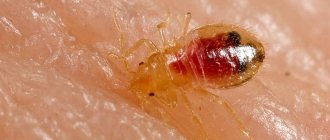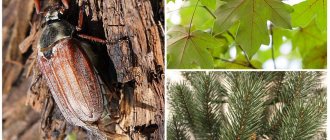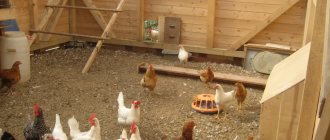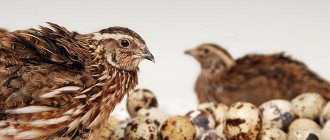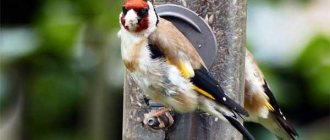Feeding wild wintering birds in your garden or park is not just an act of mercy towards our smaller brothers, but also a contribution to the future harvest. According to ornithologists, one tit can save up to 10 trees from pests per season, and one feeder provides food for up to 50 tits! Even a child knows that sunflower seeds are most often poured into the feeder. But there are many different kitchen scraps that can also become a source of food for birds. Some foods on our table are ideal for birds, while others may do more harm than good. Let's take a closer look at what you can and cannot feed birds.
What can and cannot be fed to birds in winter?
Bird feeders
Feathered creatures are warm-blooded, requiring good nutrition to maintain body temperature (+40 C). If things go poorly with nutrition, the bird’s body will begin to cool down. The instinct of self-preservation and hunger drive birds in search of food.
Compact feeders for tits and sparrows can often be found in courtyards of residential areas and parks. Concerned citizens organize similar structures on their balconies.
Bullfinches, sparrows, titmice, goldfinches, and jays flock to the feeder to eat. Often in large feeders you can meet uninvited and impudent guests - crows, jackdaws.
“Canteens” for birds can be made with your own hands or purchased at a pet store. The simplest design is a plank with a roof that protects from natural precipitation, suspended from the corners of a rectangle. There are also creative ideas for creating places for birds to feed from scrap materials. For example, from a milk carton, plastic container, tin cans.
Optimal Poultry Diet
The question arises about the bird menu. If everything is clear with the diet of wild pigeons, it is worth learning more about the optimal filling of feeders for smaller birds.
Feathered creatures are not tidy. It is common for them to defecate while eating. That is why you should not pour a lot of food into the feeder at once, which can quickly become spoiled. Also, you should not mix feeds with different structure. For example, meat or lard should not be given together with cottage cheese.
The optimal food for birds is a special complex mixture, which should be purchased at specialized pet stores.
The complex composition includes seeds:
Additionally, rowan fruits and bread crumbs are introduced into the bird’s diet. In addition to rowan, you can give birds viburnum and hawthorn berries.
If the majority of birds are completely satisfied with this diet, then such miniature birds as titmice additionally need to be fed with fatty animal food. High-calorie food quickly saturates tits and gives them more strength. Lard and meat act as animal and fatty foods. In order for the birds not to swallow large pieces, but to peck at the food gradually, it is recommended to string the pieces on a thread in the form of beads and hang them near the feeder.
In addition, there is no need to promote the development of laziness in birds. After all, if the feeders are always full of grain, they will not strain and look for a worm under the bark of trees or pick up seeds on the surface of the ground. Such conditions dull the instincts of these creatures and make them lazy and careless.
Why do tits love lard?
Small birds have very fast metabolisms and require a lot of energy just to survive. This is especially true in the cold season, when additional energy costs for protection from the cold are added. Three reasons why tits eat lard:
- they are predators, lard is their natural food;
- fat contains a lot of energy, which is so necessary for tits;
- lard is available - every second fan of feeding birds in winter hangs lard for tits.
As a child, I read a book that described an ancient method of tanning hides. After preliminary mechanical cleaning, the animal skins were hung in the barn. At the same time, access was left for tits. The birds flew up freely and pecked the remaining meat and fat from the skins, as a result of which they became softer. Perhaps the tradition of feeding tits with lard has been going on for a long time.
What are the advantages of feeding tits with fat:
- high nutritional value;
- lard is cheap, in meat departments they give pork skins for practically nothing;
- it is easy to buy, even in comparison with seeds;
- you can use any fat (pork, beef, lamb);
- the lard hangs on the branch for a long time, which allows you to feed the birds at your dachas, where you appear once a week;
- tits stay on the piece for a long time, which makes it possible to observe them well;
- the lard also attracts other birds.
Disadvantages of feeding birds lard:
- it can only be hung in cold weather - lard spoils in the heat;
- You cannot feed tits with salted lard;
- pieces of lard on the branches do not look aesthetically pleasing;
- Fat can be stolen by cats and large birds (crows, magpies, rooks), so it is better to tie it to a branch. I have a video about the rook’s attempts to steal lard.
Prohibited food
Each order of birds has its own preferences. Sparrows and pigeons rarely refuse grain, and tits love seeds and lard. Birds need to be fed wisely. The first rule to follow is to eliminate salty foods from your diet. The peculiarity of the structure of birds is that their excretory system cannot cope with excess salt and provokes poisoning and death of birds.
Roasted sunflower seeds, which can cause liver disease, are prohibited. In addition, wild birds should not be given black bread and millet . Millet can become a source of toxic substances, and black bread can cause fermentation in the intestines.
In addition to salty foods, you should not put citrus fruits, banana peels, sour or spicy foods in the feeders.
Ordinary chewing gum is especially prohibited . Pichugi, mistaking chewing gum for a tasty morsel, peck at the discarded gum and die from a paralyzed digestive tract.
Acceptable seeds and cereals
For urban pichugs, commonly used cereals can be considered as food. When you go outside, you don't have to wonder if birds eat rice. You can safely take with you a bag of millet, wheat, rice and oats.
Read also: Urticaria in pigs photo
In addition, birds will not refuse the seeds of such vegetable crops:
Forest birds love pine cone seeds and acorns. If, while going for a walk, a person takes with him a small piece of white bread, then before feeding it to the birds, he needs to crumble it.
Additionally, birds can add crushed eggshells , which will become a source of calcium for them. Chopped apple pieces, cottage cheese, and small pieces of raw beef can also be added to bird feeders.
From an early age, parents try to instill in their children a wonderful trait - love and the desire to come to the aid of our smaller brothers. The simplest step in this matter is to build a simple feeder and treat the birds from time to time. However, do adults themselves know how to properly provide this assistance so as not to harm the birds? Let's look at this interesting and at the same time difficult issue.
Is it possible to feed rice to birds in bird feeders?
One of the budget products that is found in almost every home is cereal. Most often, this is what birds are fed with. But is every grain good for them? After all, when doing good, it is important to follow a number of rules and take into account the peculiarities of the life activities of the wards.
Is it possible to give raw/cooked rice?
Many ornithologists notice that rice is most often found in street feeders. Raw or heat-treated. Do birds eat it? Yes, but you absolutely cannot do this! Rice tends to swell from moisture. Once in a bird's tiny stomach, the grains can cause her suffering.
Is it possible to put other cereals in the feeder?
Other common cereals, such as buckwheat and pearl barley, are also dangerous for birds . They have similar properties to rice and expand in a humid environment. Oatmeal and millet (unrefined millet) are considered harmless. They are sold in all pet stores.
Note! Millet is part of a special cereal mixture for birds.
Where does a sparrow usually live?
You can meet sparrows almost everywhere. They massively populate the centers of cities and towns. Habitat _
wide,
the sparrow
is found from Western Europe to the Sea of Okhotsk, in East and Central Asia. It is widespread even in Siberia.
Interesting materials:
Where was the television first invented? Where are Philips TVs assembled in Russia? Where are cherries grown in Russia? Where is the microphone in a smartphone? Where are old TVs accepted in St. Petersburg? Where is the front camera on the phone? Where is the voice recorder in a Samsung phone? Where is the app store on a Samsung TV? Where is the air conditioner located in the carriage? Where to hang the towel holder?
What is the best way to feed birds in bird feeders?
Experts recommend buying food rich in vegetable fat, such as rapeseed and flax . More budget-friendly options include raw, clean sunflower seeds (seeds). The birds will eat them without leaving a trace and will be satisfied.
Sample “healthy eating menu” for street birds:
- Lard (visceral fat). It must be raw, and in no case smoked, salted or peppered. Raw lard helps birds stay full for a long time due to its caloric and nutritional content. It is not necessary to chop it, just hang a piece by a wire. Then it will be convenient for the birds to sit on it and peck in small portions.
- Coconut and unsalted butter are very good food for insectivorous birds (great tits, nuthatches, blue tits, blackbirds, etc.). You can add a mixture of various grains and seeds to butter, freeze it, make a hole in the prepared form and thread it through a rope.
- Dried berries of red and black rowan, serviceberry, elderberry, hawthorn, blueberry, etc.
- Dried fruits (apples, pears). They are popular with starlings, waxwings and thrushes.
- Unroasted melon, watermelon, and pumpkin seeds.
- Woodpeckers and nuthatches prefer chopped nuts (walnuts, peanuts).
- Lightly salted cheese, cut into small cubes.
- Dry crumbs of white bread are a real treat for sparrows.
- Ready-made mixtures for birds from the pet store.
Literature used in the article:
- Aggressive behavior of the great tit Parus major when defending the nest. V.A.Koshcheev // Russian Ornithological Journal 2022, Volume 28, Express Issue 1822
- Once again about the eating of soap by the great tit Parus major. V.G.Prokhorov//Russian Ornithological Journal 2022, Volume 26
- Food storage in tits Parus spp. and the nuthatch Sitta europaea. A.V.Bardin // Russian Ornithological Journal 2022, Volume 27, Express Issue 1585
- Great tit Parus major feeding on the carcass of a rock pigeon Columba livia. N.N. Berezovikov, A.N. Filimonov // Russian Ornithological Journal 2022, Volume 27, Express Issue 1574
- On the feeding of the great tit Parus major by honey bees Apis mellifera. V.P.Ivanchev // Russian Ornithological Journal 2016, Volume 25, Express issue 1277
- About the consumption of unusual food by great tits Parus major - soap and corn grains. Knysh N.P. // Rus. ornithol. magazine 23 (970): 2014.
- Relationship between the great tit and the urban landscape in winter. Kovalev V.A. Prisada I.A. // Magazine Berkut No. 5, 1996.
- Seasonal dynamics of the food supply and diet of great tit (Parus major) chicks. T.A. Ilyina // Materials of the I All-Russian Scientific Conference “Evolutionary and Ecological Aspects of the Study of Living Matter”. Cherepovets, February 8–9, 2022
What should not be given as food
Birds are prohibited from feeding spoiled food supplies that have fermented and are covered with mold. But there are also a number of restrictions that apply to products familiar to humans. They can cause irreparable damage to the health of birds and even threaten their lives :
- Salted seeds , pistachios, cookies, crackers. Birds do not have sweat glands. The entire burden of removing excess salt from the body falls on the kidneys, so they may refuse heavily salted food. The musculoskeletal system also suffers, because some salts tend to be deposited in the joints. Then any movement of the bird will cause severe pain.
- Roasted nuts . This is where fats can cause harm to the body. When oversaturated with them, the organs of the digestive system (pancreas, liver) suffer.
- Rye bread . Due to the accelerated fermentation process, a situation often arises when the bird is blocked from breathing due to gases. This happens because the goiter begins to compress the trachea.
- Fresh wheat bread . It is dangerous because in a humid environment it turns into a sticky substance. It has difficulty moving through the digestive tract and causes indigestion.
- Cherry , peach, apricot kernels, as well as almonds. They are easy to poison because they are rich in hydrocyanic acid.
- Old, rancid millet . Harmful fats accumulate on its surface.
- Potato . The alkaloid solanine, which is found in raw tubers, causes poisoning in birds. The high concentration of starch in boiled potatoes creates an unwanted burden on the stomach.
- Mushrooms . When consuming mushrooms, there is a high probability that spores of clostridia, the causative agent of botulism, will enter the bird’s body.
- Canned food . When preserving foods, sugar, salt, and vinegar are used that are harmful to poultry health.
Read also New Year's Prizes for competitions
General rules for complementary feeding
Once you start feeding birds, make it a habit. Regularly delight them with healthy treats. Birds quickly remember the place of feeding and get used to it . Don't forget: we are responsible for those we have tamed!
Important! The more varied you organize your menu, the more species of birds will be interested in your feeder.
From time to time, empty the feeder of leftover food. Rot and mold are fertile ground for the development of harmful microorganisms .
Is it possible to feed rice to poultry?
Most inexperienced farmers are interested in whether it is possible to add rice to bird feed. It seems that it is the same grain as barley, wheat and others. A limited amount of rice, rich in carbohydrates, minerals and B vitamins, will not harm the bird and will have time to be absorbed. However, overuse of this cereal can cause paralysis and even death in chickens .
It is recommended to feed rice to birds during the daytime . Mix it, for example, with vegetables, grass or other feed.
Occasionally feed the birds with boiled rice diluted with milk . Chickens especially love this delicacy. They quickly get full and become energetic.
It is useful to feed birds rice flour and chaff:
- Mix rice (preferably unpolished) and other food in a ratio of 1:3.
- Dilute a little with water or milk.
Feeding rice alone or its frequent use is unacceptable . The productivity and well-being of a bird depends on the diversity of its diet.
How to get kids involved in bird feeding
It is best to feed birds in winter together with children. This way they will learn to care for our smaller brothers and love nature. To do this, you can turn feeding tits and sparrows into a game.
For example, one piece of lard can be tied to a branch, and from the bottom you can make a small swing from another piece. This way the birds will have lunch, and the children will have fun seeing a titmouse on a swing.
If you wait long enough, the bird will take food even from human hands, but for this you will need to be patient.
Alternatively, you can take the pine cones and roll them in bird treats, and then hang them on tree branches. Simply put, the act of simply feeding birds during the winter season can lift spirits even in inclement weather. Everything, of course, depends on a person’s imagination.
What can you feed the birds?
Seeds. Unroasted sunflower seeds can be an excellent food for birds. You can also give pre-dried seeds of watermelon and melon, pumpkin and even zucchini.
Cereals. Is it possible to feed birds millet in winter? Not all experts advise doing this, but the main thing is that the cereal is without added oil, salt, or sugar. It is much better to give the birds oats, rice, millet, pearl barley, dense oat flakes (intended for long cooking) and rolled oats, as well as dried corn.
From fruits, you can treat your feathered friends with apple slices and dried berries.
Thrushes, bullfinches and waxwings, as well as some other forest birds, readily feed on berries of rowan, viburnum, bird cherry, hawthorn, cranberry, and lingonberry, collected and dried by humans in advance.
For some insectivorous birds, consuming a boiled egg will have a good effect, because this product is a source of protein in its pure form.
Read also Watermelon seeds for birds
What foods are poisonous to squirrels?
Toxic foods are poisonous to squirrels and should be avoided completely. … UNHEALTHY FOODS
- Foods high in sugar (candy, cookies, muesli, sugary breakfast cereals)
- Foods high in starch (pasta, bread, rice, potatoes)
- Salty food.
- Fast food for humans.
- Cashew nuts.
- Sunflower seeds.
- Dried corn.
- Pine nuts.
THIS IS INTERESTING: How long does it take to learn how to cook?
What should you not feed birds in a feeder in winter?
Now let's look at the prohibitions. So, the main thing that is prohibited and in no case should appear on the menu of feathered friends is:
- Fried and salted - it is correct to give seeds and nuts only unprocessed and not fried, and lard should only be in its pure form, always without the addition of seasonings and spices, salt. “White Death” is a direct poison for feathered friends, since their body is not able to process it, and therefore the animals will certainly die.
- Products made from rye flour - black bread and other derivatives can lead to gastrointestinal upset and death of animals. In general, bread is not the best food for them, because, as a rule, it contains salt, sugar, and baker's yeast. However, it is permissible to put a little crumbled, dried white bread and crackers in the feeder, but they must certainly be unleavened.
- Spicy and sour foods, all citrus fruits (and even their peels!) are also prohibited.
- Any type of cabbage, potatoes, onions, greens should not be included in the bird's diet.
- Bananas and their peels can have a detrimental effect on the body of birds.
- Milk and all dairy products are also prohibited.
- Among the cereals, buckwheat, peas, and wheat groats can cause harm to them.
- Sweet baked goods and yeast baked goods are not allowed.
In addition, you should not feed birds expired and spoiled food - such food is not healthy not only for humans, but also for animals!
You will find a more detailed answer to the question of what is the best way to feed birds outdoors in winter and why, as well as advice from an ornithologist biologist in the following video:
A little advice from ornithologists: it is better to hang some bird food (for example, crackers or a piece of lard) from a branch on a tight rope so that the birds can “peck” it, but do not drop or lose it, and also so that they do not swallow food too large for them. them in pieces.
What food is best for feeding wild birds?
The high nutritional value and high calorie content of the food will give the birds a lot of energy and ensure the creation of fat reserves that will help the birds survive the cold winter nights. Therefore, you need to feed the birds in your garden with quality food.
Most garden bird species will enjoy sunflower seeds, nuts, and live or dried mealworms. For convenience, you can use ready-made specialized high-quality mixtures for birds. At the same time, choose food that contains a large amount of sunflower and millet seeds. Mixtures with lots of unappetizing fillers, such as wheat and corn, are not very attractive to birds.
Avoid seed mixtures that contain beans, peas, rice and lentils. Only large species of birds can consume them in dry form, but such birds very rarely fly to feeders. But prepared bird food and sunflower seeds are not the only suitable foods you can feed your birds.
By using kitchen scraps as bird food, you are using your excess food for a good cause. But you could just throw them away! By turning waste into food for birds, you have nothing to lose. And the birds enjoy a wide variety of food, flying to the feeders again and again.
Attention: do not forget that the basis of the diet when feeding birds should still be specialized mixtures or sunflower seeds. If birds ate nothing but kitchen scraps, they would not be able to obtain enough nutrients for healthy growth and energy. However, poor nutrition can lead to health problems, such as obesity or feather deformation. To avoid harm, offer food scraps in limited quantities.
The most frequent visitor to feeders is the common great tit, which is capable of eating a wide variety of food types. © Lyudmila Svetlitskaya
conclusions
As conclusions, here is a complete guide and advice from ornithologists in one table:
| What can you feed | What not to feed |
| Unroasted and unsalted sunflower, pumpkin, flax, watermelon and melon seeds | Black rye bread |
| Unsalted lard and meat | Millet and wheat groats |
| Dried berries: rowan, viburnum, bird cherry, hawthorn, cranberry, lingonberry | Baked goods and yeast baked goods |
| Wheat bread crackers | Potatoes, peas, cabbage, onions, spicy herbs |
| Eggshells and chalk | Dairy |
| Boiled eggs | Any salted, fried, smoked, spicy foods |
| Non-roasted nuts: walnuts, pine nuts, hazelnuts, almonds, cashews, peanuts | Spoiled food, rancid grain products |
| Cereals: oats, rice, millet, pearl barley, oatmeal | Cereals: millet, buckwheat and barley crops |
General feeding rules
First of all, it is important to remember: we are only talking about feeding, so there should be enough food for your feathered charges to eat it at one time.
An enhanced diet is justified only in severe frosts. This may seem cruel, but if you give titmice too much food, they will quickly get used to the “easy” life and lose the ability to look for food on their own.
To set up a bird canteen, it is advisable to find a secluded place located high enough above the ground so that rodents and pets cannot reach it. Schedule feeding at a certain time, and the smart titmouse will quickly learn the daily routine.
Months when tits (and other birds wintering in the city) need feeding:
- from early November to mid-April.
It is important to take into account that the titmouse needs to adhere to a certain “diet”. Prohibited:
- Any bread baked with yeast that causes fermentation in the stomach
- Fried foods, everything salty, spicy, sweet.
- Raw cereals, dairy products, potatoes, cabbage, peas.
The best treats for the yellow-breasted tiny bird would be:
- Any raw seeds: pumpkin, flax, sunflower;
- Dried berries of rowan, hawthorn, cranberry, lingonberry;
- Crushed almonds, peanuts, walnuts (also raw);
- Finely crushed hard-boiled egg, apple slices, unleavened bread.
- And, of course, lard.
General rules for complementary feeding and how to install the feeder correctly
In addition to choosing food, it is also important to choose the right place to install the feeder. So, it is better to choose small edges or clearings where birds often fly. It is better to install the “house” at a height where other animals and children, who may accidentally or deliberately spill food or add something harmful, cannot reach it.
You should also take care of the feeder itself. Ideally, it should be made of moisture-resistant material, otherwise it and all its contents will have to be changed every couple of days. So, any plastic bottle or jar in which you can cut out a “window” would be an excellent option from childhood. It should be such a width that the bird can easily get inside and fly out freely.
How to feed tits?
It is very important to maintain regularity. If you decide to support the birds, then you should add food once or twice a day at a certain time. Small birds very quickly get used to the feeder, and if at the right time they don’t find food in the usual place, they may get confused and not have time to get it somewhere else, especially when it’s evening and it’s frosty outside. Therefore, if you have a choice - to arrange a one-time “feast for the whole world” or to feed little by little constantly, you should always choose the second. If you are not sure that you can add food regularly, pay attention to lard, it is consumed little by little, you can hang it up and change it only as it is consumed. In general, options are possible. The main thing is good will - and the desire to help birds in difficult times.
